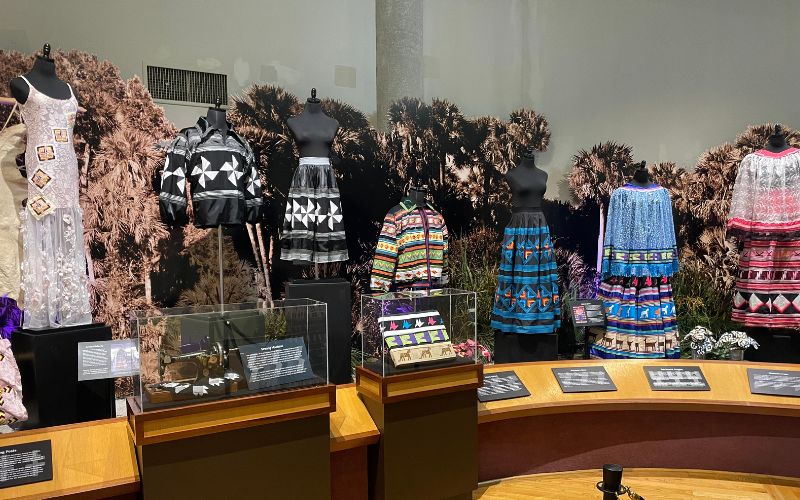
- Details
- By Kaili Berg
Running through June 2025 in the East Gallery, the exhibit features the work of over 20 Seminole sewing artists from multiple Seminole reservations, including Trail and Big Cypress, creating a vibrant homage to a heritage craft central to Seminole culture.
Taweekaache, which translates to “stitching” in Mikasuki, highlights the deep cultural roots and evolution of Seminole patchwork garments. Known for their bold patterns and meticulous craftsmanship, these garments carry both artistic and historical significance, as each stitch reflects the ongoing legacy of Seminole identity and resilience.
The exhibit guides visitors through the origins and evolution of this tradition, showcasing the way it has been adapted and preserved by each generation.
The exhibit includes exclusive video interviews with renowned Seminole artists Lenora Roberts and Melissa Osceola DeMayo. Through these segments, visitors can gain a glimpse into the dedication and skill required for the intricate designs, which often incorporate tiny, meticulously sewn pieces.
“Patchwork has grown and evolved over time, becoming more intricate and beautiful with each generation,” says DeMayo in the exhibit’s video segment. “This exhibit honors the past while showcasing how the tradition continues to thrive today.”
More Stories Like This
Vision Maker Media Honors MacDonald Siblings With 2025 Frank Blythe AwardFirst Tribally Owned Gallery in Tulsa Debuts ‘Mvskokvlke: Road of Strength’
Zuni Youth Enrichment Project and Partners at Ho’n A:wan Productions Launch 8th Annual Delapna:we Project
Chickasaw Holiday Art Market Returns to Sulphur on Dec. 6
Center for Native Futures Hosts Third Mound Summit on Contemporary Native Arts
Help us defend tribal sovereignty.
At Native News Online, our mission is rooted in telling the stories that strengthen sovereignty and uplift Indigenous voices — not just at year’s end, but every single day.
Because of your generosity last year, we were able to keep our reporters on the ground in tribal communities, at national gatherings and in the halls of Congress — covering the issues that matter most to Indian Country: sovereignty, culture, education, health and economic opportunity.
That support sustained us through a tough year in 2025. Now, as we look to the year ahead, we need your help right now to ensure warrior journalism remains strong — reporting that defends tribal sovereignty, amplifies Native truth, and holds power accountable.
 The stakes couldn't be higher. Your support keeps Native voices heard, Native stories told and Native sovereignty defended.
The stakes couldn't be higher. Your support keeps Native voices heard, Native stories told and Native sovereignty defended.
Stand with Warrior Journalism today.
Levi Rickert (Potawatomi), Editor & Publisher


